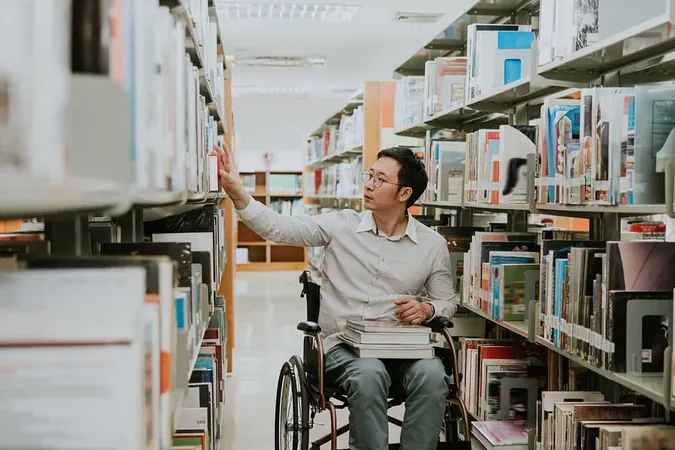
Urgent Call for Change: Disabled Scientists Demand Better Support and Inclusivity in STEM Fields
2025-03-31
Author: Ming
Groundbreaking Report on Disabled Scientists
A groundbreaking report released by the National Association of Disabled Staff Networks (NADSN) has shed light on the urgent need for improved support and recognition of disabled individuals in the scientific community. The report emphasizes a paradigm shift is necessary to prevent the alarming trend of disabled people dropping out of scientific careers.
Current Statistics
Currently, an estimated 22% of working-age adults in the UK are disabled. However, only 6.4% of individuals in scientific roles identify as disabled, plummeting to a mere 4% among senior academic positions. Shockingly, only about 1% of research grant applications received by UK Research and Innovation come from disabled researchers, and those who do secure funds receive, on average, less than half of the amount given to their non-disabled counterparts.
NADSN's Initiatives
NADSN, which acts as a network for disabled staff in higher education, highlighted that their STEMM Action Group, established in 2020, consists of nine scientists who have firsthand experience with disabilities. Their ongoing efforts aim to provide actionable recommendations to funding bodies, academic institutions, and learned societies to dismantle the barriers faced by disabled individuals in the STEM (Science, Technology, Engineering, Mathematics) fields.
Identifying Obstacles
Previous findings by the group identified a range of significant obstacles that disabled scientists encounter. These include the need for digital accessibility—like using readable fonts in presentations—as well as physical access to crucial facilities, such as ramps and automatic doors. Offices equipped with adjustable desks and labs accessible for wheelchairs are also essentials that are often overlooked in planning.
Francesca Doddato's Insights
Francesca Doddato, a physicist at Lancaster University and a co-author of the latest report, emphasized that many of the most critical physical accommodations are often treated as afterthoughts during planning stages, leading to costly and cumbersome implementations later on. 'We need a fundamental shift in our approach to disability inclusion,' she insists.
Toxic Work Culture
Beyond physical barriers, the report reveals a toxic culture entrenched in many research environments, where approximately 62% of disabled scientists report experiences of bullying and harassment, compared to 43% of their non-disabled peers. 'The pressure to be hyper-productive and a relentless focus on quantity over quality creates an atmosphere that marginalizes disabled individuals,' notes Doddato.
Call to Action
To address these issues, the recent report titled *Towards a Fully Inclusive Environment for Disabled People in STEMM* outlines several critical reform areas. It calls for the promotion of inclusive workplace cultures, enhancement of accessible physical and digital environments, and proactive funding strategies.
Short-term and Long-term Goals
In the short term, the report encourages all stakeholders to acknowledge the unique challenges faced by disabled researchers while improving training for managers. Simple steps, like sharing meeting agendas and ensuring documents are readily accessible, could create a more supportive atmosphere. 'Being an ally is essential,' Doddato emphasizes.
The report also sets medium- and long-term goals aimed at holding organizations accountable for their policies and practices, advocating that funding bodies should no longer support institutions that uphold toxic cultures. Moreover, it champions a reform in equality law to recognize the intersectional discrimination that many disabled people experience, acknowledging this will be an extensive undertaking.
Conclusion
Doddato concludes with a passionate call for change: 'We need to amplify disabled people’s voices transparently to ensure their perspectives are not only discussed but implemented meaningfully. It's time for a dramatic shift in how we perceive and address disability inclusion in science.'
The time is ripe for transformation, and this pivotal report could be the catalyst needed to reshape the scientific landscape for generations to come.
 Brasil (PT)
Brasil (PT)
 Canada (EN)
Canada (EN)
 Chile (ES)
Chile (ES)
 Česko (CS)
Česko (CS)
 대한민국 (KO)
대한민국 (KO)
 España (ES)
España (ES)
 France (FR)
France (FR)
 Hong Kong (EN)
Hong Kong (EN)
 Italia (IT)
Italia (IT)
 日本 (JA)
日本 (JA)
 Magyarország (HU)
Magyarország (HU)
 Norge (NO)
Norge (NO)
 Polska (PL)
Polska (PL)
 Schweiz (DE)
Schweiz (DE)
 Singapore (EN)
Singapore (EN)
 Sverige (SV)
Sverige (SV)
 Suomi (FI)
Suomi (FI)
 Türkiye (TR)
Türkiye (TR)
 الإمارات العربية المتحدة (AR)
الإمارات العربية المتحدة (AR)